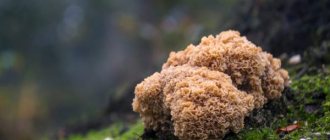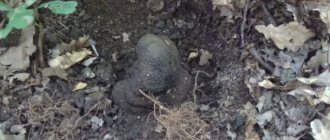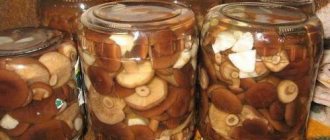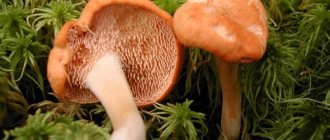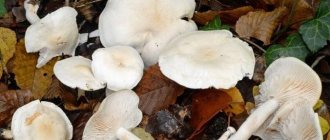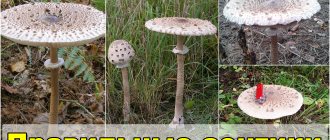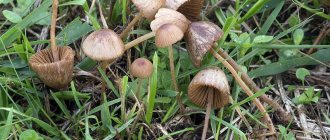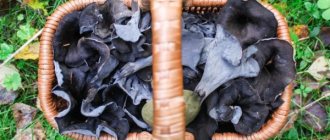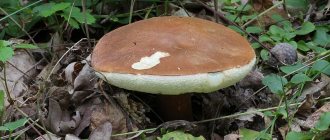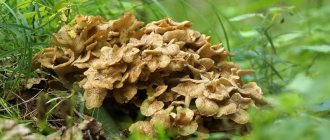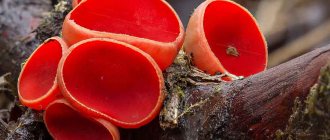The curly or curly sparassis mushroom (Latin name: Sparassis crispa) is an edible species of the sparassis family, a division of basidiomycetes. Its other names are: Dryagel curly, Sparassis curly or cabbage. Common names: hare cabbage, hog cabbage, head of mushroom or ram.
During development, its spores penetrate the surface of the tree, and when the shoots begin to deform, crusts of red rot form on them. In other words, it is a plant parasite, like other tinder fungi.
Curly Sparassis
This mushroom looks more like some kind of fancy flower or a head of cauliflower.
Sparassis curly is a very unusual and interesting organism, and also very rare - it is listed in the Red Book.
Curly sparassis (Sparassis crispa) belongs to the Sparasaceae family, which unites only 7 species. This edible mushroom, due to its unusual appearance, has several names: mushroom happiness, mushroom cabbage, ram mushroom, hare cabbage, curly friegel, hog cabbage and king mushroom. By the way, the name “ram mushroom” in relation to sparassis is usually used only in foreign reference books. By this name, Russian mycologists mean one of the tinder fungi - curly griffola.
- the fruiting body consists of a large number of fleshy, curly, branched lobes and resembles a lush spherical bush. The dense lobes are smooth or wrinkled and have a dissected or wavy edge. The mushroom sometimes reaches quite large sizes: the diameter of the fruiting body is usually 6-35 cm, but individual specimens grow to a record 60 cm. Its height is about 20 cm, and its weight often exceeds 6-8 kg: it happens that mushrooms weighing up to 14 kg. The color of the fruiting body in young mushrooms is whitish-yellow, and in mature ones it is brown with a hint of rust; the stem is root-shaped, attached to the middle of the fruiting body, thick (up to 5 cm in diameter), goes deep into the ground and is therefore little noticeable. Its length is about 13 cm. The color is yellowish-white, sometimes darkening with age to black; the flesh is dense and fleshy, fragile in young specimens, similar to wax, in adults it is hardened and hard. It has a nutty taste and emits a strange smell that is not at all similar to the aroma of mushrooms; the spore-bearing layer is located on one side of each blade of the fruiting body. It has a grayish or white-cream tint, slightly rough to the touch or, conversely, smooth; spores are ellipsoid, from white to light yellow.
Mushroom happiness: using mushrooms
In traditional Chinese medicine, the fungus mushroom is used to normalize blood pressure, regulate blood sugar levels, and to prevent strokes and tumor diseases.
Edible at a young age, the mushroom has good taste and does not require pre-boiling. Suitable for all types of culinary processing, can be dried, not suitable for pickling or pickling. Since mushroom cabbage contains substances that prevent the development of mold fungi, the fruiting body can be stored for a long time at low temperatures (in the refrigerator).
www.5lepestkov.com
Growing at home
Cultivating curly sparassis, like all other mushrooms that grow on wood, is relatively easy. The technology is reminiscent of growing oyster mushrooms at home, but they use sawdust from coniferous trees rather than deciduous trees, since Curly Sparassis prefers to grow on pines, spruces, cedars, fir and larches.
In order to prepare a nutritious substrate, very fresh sawdust is used, which should not contain even traces of chemicals that are used to treat wood in the fight against harmful insects and pathogenic microorganisms.
To improve the nutritional qualities of sawdust and obtain a finished substrate, they are mixed with hay, bran, gypsum and a combined mineral additive in small quantities. Next, they get rid of the microorganisms present in the substrate. To do this, the mixture of sawdust with additives is poured with water, brought to a boil and boiled for 1-2 hours.
After the solution has cooled, the water is drained and the substrate is laid out on a fine mesh while excess water drains from it. The optimal moisture level for sawdust is 70%. The mixture reaches this indicator after 10-14 hours of drying on the grid. Ready sawdust is determined by the fact that it becomes wet to the touch, but does not stick to your hands.
The substrate, freed from excess water, is placed in layers of 5 cm in a plastic bag, each layer is sprinkled with crushed mycelium of curly Sparassis. After this, the bag is tied tightly. After some time, the mycelium will germinate and entangle the entire substrate with a thick net, which turns into a monolithic block. After this, holes of 2 cm by 2 cm are carefully cut in the bag so that the fruiting bodies can break through them in the future.
If there is a plot of land in the garden, in a greenhouse or in a vegetable garden, curly sparassis is also grown on wood logs. The advantage of this method is that it does not require regular replacement of the substrate, since on solid wood the mycelium continues to bear fruit for several years, and not just one or two seasons, as in the previous case.
For Sparassis curly, both sawdust and wood are chosen from coniferous trees. The size of the barrel depends on the ease of use. Both large logs about 10 m long and up to 30 cm in diameter, and small saw cuts 10-30 cm long are used. The wood must be freshly cut, or with a short shelf life. This, on the one hand, eliminates the possibility of infection by competitive species, and on the other hand, eliminates the need for additional moisture. In addition, curly sparassis prefers fresh “food” over dry and stale food.
In the trunk at a distance of 10-15 cm, cuts are made with a drill, then fungal mycelium is introduced into them and the holes are sealed with sawdust. The trunk is placed in a shady place in the garden or greenhouse. Along its entire length it should be in contact with the soil, without sagging anywhere. In this position, the wood will not dry out, since it will be able to take moisture directly from the soil.
Option 1: Hearty stewed cabbage with mushrooms - a classic recipe
Stewed cabbage prepared according to the classic recipe is not only tasty, but also nutritious, despite the fact that no meat is added to the dish. In terms of nutritional value, mushrooms can completely replace it. You can stew cabbage with any lamellar mushrooms. These can be champignons, oyster mushrooms or forest mushrooms, such as honey mushrooms and chanterelles.
When choosing cabbage, you should pay attention to the following: the cabbage should be dense, with juicy leaves and preferably white. Salad, the leaves of which have a greenish tint, is not suitable for stewing.
Ingredients:
- half a kilo of fresh white cabbage;
- champignons – 300 gr.;
- one carrot and a large onion;
- five tablespoons of frozen butter and one of tomato paste;
- a small bay leaf;
- drinking water - half a glass.
Step-by-step recipe for stewed cabbage with mushrooms
We clean the champignons from dirt. After rinsing thoroughly, place in a colander or on a clean towel to dry. Dissolve the mushrooms into thin slices; small ones can be left whole.
In a massive frying pan, heat a couple of tablespoons of oil and fry the mushrooms in it until fully cooked. We do not cover with a lid, all the moisture should evaporate completely, and the champignon slices should be slightly browned.
Cut the cabbage into thin and short strips. Having poured it into a bowl, coarsely grate the carrots into it and, while stirring, squeeze it lightly with your hands. Chop the onion into small cubes.
In a deep frying pan or small cauldron, heat the remaining oil and lower the onion into it. Stirring, saute the slices until they lose their dullness. Add cabbage to the onion and add some salt. Stirring occasionally, cook over medium heat until the cabbage is soft, about half an hour.
Stir tomato and previously fried champignons into the cabbage, add bay leaves. If you think the dish is a little dry, add warm water and, covering it with a lid, bring it to readiness. Simmer over low heat for another ten minutes.
Sparassis curly - description of where it grows, the toxicity of the mushroom
Sparassis curly is understood in the literal sense of the word as a curly beige mushroom, which is classified as a member of the Sparass family. There are no more than 7 varieties in this family, which is remarkable. The mushroom is an edible and very tasty variety, but it is listed in the Red Book of our country as an endangered type. Due to deforestation and human gathering, the number of specimens presented is decreasing. Today we will study everything connected with them.
Let us repeat once again that this variety is classified as edible.
The mushroom attracts attention, first of all, because it is famous for its external characteristics. In common people it is called by different names, including mushroom cabbage, lamb mushroom, mushroom happiness, as well as hare cabbage and king mushroom
Moreover, the name “lamb” is used only in foreign reference materials; our compatriots practically do not express it this way. Russian experts by lamb mean a completely different mushroom - curly griffola. Now consider the description of the presented intricate specimen. The fruiting body consists of multiple curly leaves that branch and look like a shrub. The mushroom is quite large; its wrinkled lobes with wavy edges cannot go unnoticed. Considering the diameter, we can say that some fruiting bodies grow up to 20-60 cm. Of course, this is rare; on average, mushrooms with a diameter of 7-30 cm are found. The height of the bush is about 20 cm, and its weight exceeds 6-8 kg . Some mushroom pickers came across specimens weighing 10-14 kg. The fruit bodies are beige, yellow-white in color. Mature specimens have a dark, brownish color with reddish splashes. The base is poorly visible, it is root-like, attached to the center of the body. The thickness of the leg is about 5 cm, for the most part it is dug into the ground, so it is not visible. It grows up to 13 cm in length, is colored white-yellow, and can darken and turn black when overripe. The soft part of the peculiar wavy blades is fragile, easily crumbles and breaks. In mature fruiting bodies it is tough and hard. It tastes nutty and smells strange. The smell has nothing to do with mushroom aroma. Reproduction is carried out by elliptical-shaped spores; they are light yellow or white in color. The layer, otherwise called spore-bearing, prefers to be located on each blade. Moreover, it occupies only one side, without completely wrapping around. In hue, this layer is pigmented creamy white or gray. Feels a little rough, maybe too smooth.
Growing Sparassis on tree trunks
If you have a suitable plot of land, for example, in a garden, in a greenhouse, or even in a specially designated plot of vegetable garden, hare cabbage can also be grown on solid logs of wood. This method is good because it does not require the hassle of regularly replacing the substrate, since on solid wood the mycelium will grow for several years in a row, rather than one or two seasons.
As in the case of sawdust for sparassis, you need to choose coniferous tree trunks. The size of the barrel is determined only by issues of convenience. If desired, you can use either a huge log ten meters long and 30 centimeters in diameter, or small cuts several tens of centimeters long.
It is highly desirable that the wood be freshly cut or have a short shelf life. This not only eliminates the possibility of infection by competitive species, but also eliminates the need for additional moisture. In addition, sparassis, in principle, prefers fresh “food” to dry and stale food.
In the trunk, cuts are made with a drill in increments of 10-15 cm, which are then inoculated with mycelium and sealed with the same sawdust. The trunk is then placed in a shady part of the garden or in a greenhouse so that it is in contact with the ground along its entire length and does not sag anywhere. This eliminates the possibility of the wood drying out: it itself will draw moisture directly from the soil.
Mushroom cabbage
Sparassis curly
, or
Curly Sparassis
(lat. Sparassis crispa) is a species of edible mushrooms from the genus Sparassis of the Sparasaceae family. A parasite (causes red rot) that grows on tree roots. As a rare species, it is included in the Red Book of Russia and the Red Book of the Republic of Belarus.
Other Russian names:
- mushroom cabbage, bog cabbage
- hare cabbage
- curly dragel
- "mushroom happiness"
- ram mushroom (this non-scientific name is used mainly in translations of books by foreign authors. In domestic mycological literature, this name is applied to another species - Grifola frondosa
(Fr.) SPGray from the Fomitopsis family) - king mushroom
The fruiting body of the fungus is bush-shaped, round, spherical or irregularly spherical in shape, 5-20 cm tall and 6-30 (up to 60 or more) cm in diameter, sometimes reaching a weight of 6-10 kg. It consists of a mass of branches or lobes extending from short branches, which have a hymenium on both sides. The lobes are flat, wide (0.7-3 cm wide and 0.3-0.8 cm thick), with a wavy and often dissected edge. Externally, the fruiting body of the mushroom resembles the head of a cauliflower. Young mushrooms are whitish, later yellowish, and finally, when ripe and dry, ocher or brownish. The edges of the blades usually darken first.
The flesh of the mushroom is white, dense, brittle in young mushrooms (over time and when dried, it takes on a hard, waxy-horn-like consistency), with a strong specific odor, not similar to a mushroom one. It tastes like a nut.
The hymenophore is smooth or rough, waxy, whitish-cream or grayish.
The stem of the mushroom is central, thick (2-5 cm in diameter), deeply buried in the ground, so that despite its length (5-13 cm) it is hardly noticeable from the outside. The color of the stem of young mushrooms is whitish or yellowish, later brownish to black.
Spore powder - from whitish and yellowish to ocher and orange-ocher. Spores (6-7) × (4-5) microns, ellipsoidal, slightly narrowed at the base, smooth, colorless, with a large drop of oil.
Sometimes the fungus forms a pseudosclerotium measuring (20-70) × (7-10) cm, consisting of soil particles intertwined with mycelium, and attached to the roots of a tree.
Growth
Spreading
Occurs from August to October, sometimes starting in late July. A parasitic wood-decaying fungus, saprotrophic or weakly phytopathogenic, causing rotting of roots and wood. It grows solitary on roots, at the base of trunks, less often on fresh stumps of coniferous trees (mainly pine, but also spruce, cedar, fir, larch) in old-growth coniferous and coniferous-deciduous forests. Fruiting bodies are formed at the butt of the tree, connected by strands of mycelium to the affected root. The fungus causes red-brown destructive rot of the roots and base of the trunk. At the final stage of development, rotten wood cracks, and clusters of mycelium are observed in the cracks.
Similar species
Very similar to curly sparassis is the rarer lamellar sparassis (Sprassis laminosa), which parasitizes oak. The fruiting body of this mushroom is straw-yellow, and the blades are coarser, dense, and entire.
External views
Ram mushroom (Grifola frondosa (Fr.) SPGray) and branched tinder fungus (Grifola umballata (Fr.) Pil.), growing at the base of trunks and stumps of deciduous trees (oaks, elms, etc.). Red Book of the Russian Federation.
Use
An edible mushroom, used mainly for making soups, frying and drying. However, curly sparassis is edible only at a young age - the fruiting bodies, which have acquired a brownish color, become very hard. Used in folk medicine. Contains sparassol, which prevents the development of mold fungi. In addition to sparassol, curly sparassis contains bioactive components that have antitumor (immunomodulatory) and antimicrobial activity.
Security status
Sparassis curly is listed in the Red Book of the Russian Federation with the status III (R) rare species and in the Red Book of the Republic of Belarus. Factors limiting its numbers are the increased exploitation of forests and the collection of fruiting bodies by the population.
Sparassis curly - photo and description
The sparassis mushroom is known under different names - curly, curly and curly sparassis, hare, mushroom and hog cabbage, ram mushroom (however, this name is often used in relation to another type of mushroom). Sparassis is a good edible mushroom and a typical representative of the biological genus and family of the same name.
Unlike most forest mushrooms, the fruiting body of sparassis has the shape of a round, spherical or irregular bush. Its height and diameter reach 5-20 cm, and often the diameter exceeds half a meter. For this reason, the weight of one mushroom can easily reach several kilograms. The structure of the fruiting body consists of many “curly” branches or lobes growing from a common root. The branches are flat and wide (up to 3 cm), but very wavy, often with dissected edges. In general, the appearance of the fruiting body is very similar to the cauliflower fruit, but only more “loose”.
Young sparassis has a whitish color, which gradually becomes yellowish with age, and in “old age” ocher or even brown. Darkening usually begins at the edge of the blades.
Inside the mushroom there is white dense pulp, which has a strong smell, completely different from mushroom. At the same time, the taste of the pulp strongly resembles a nut. In young fruits, the flesh is brittle, but over time it becomes tougher and even woody.
Although the central leg from which all the blades grow is quite long (up to 13 cm) and wide (up to 5 cm), from the outside it is almost invisible, since it goes deep into the ground. While the mushroom is young, the color of the stem takes on one of the shades between white and pale yellow. But as it ages, the leg darkens greatly, acquiring a brown or even black color.
Rabbit cabbage is a parasitic fungus that destroys wood. It often provokes rotting of the roots and supporting trunk of the tree on which it parasitizes. It usually grows on the rhizome or at the base of the trunk, but is sometimes found on fresh stumps. Sparassis prefers coniferous trees, primarily pine, spruce, cedar, fir and larch. (If you come across a similar mushroom in the forest that parasitizes an oak tree, it is Sparassis lamellar, another type of mushroom, although closely related). In a tree affected by mushroom cabbage, red-brown rot of the roots and lower part of the trunk gradually develops. In the later stages of the disease, the tree dies.
The fruiting bodies of Sparassis curly appear on the surface of the wood from August to October. Occasionally, the first mushrooms may ripen as early as the end of July. Sparassis is a fairly rare but widespread mushroom. Its populations are always very small, but they can be found in many parts of the temperate zone of the northern hemisphere. In Russia it can be found almost everywhere from Karelia in the north to the North Caucasus in the south and from Sakhalin in the east to the Moscow region in the west.
Evaluation of taste qualities, medicinal properties, benefits and possible harm
Curly mushroom belongs to the edible class; it can become the basis of soup, mashed potatoes or pie. Hare cabbage can be dried, fried, ground into flour and sprinkled on dishes. Only young inflorescences and stems of mushrooms are considered edible. With age, they become as hard as possible, acquire a brown color and a distinct bitter taste. But curly mushrooms stand out for their taste characteristics; their texture is similar to morels. The smell is special, reminiscent of almonds.
Treatment
Traditional medicine has long been using curly mushroom to treat many diseases, including even oncology. This is an effective remedy against tumors, it boosts immunity, kills germs and fungi.
The benefits of hare cabbage have been proven in the treatment of even hepatitis of viral etiology. In the field of gynecology, curly mushroom is useful for protection against hormonal ailments. This type is also used in the treatment of diabetes. It actively helps reduce sugar thanks to proteins and numerous minerals. It can be boiled, fried, dried, and it is always delicious.
Use in folk medicine
Traditional medicine uses the properties of sparassis, which are officially recognized. The pharmaceutical industry works with extracts of the plant product, adding them to cream products for facial rejuvenation. Traditional medicine has collected recipes for preparing masks for the treatment of skin diseases.
In addition, the effectiveness of the use of the mushroom component of Sparassis curly in the elimination of oncological tumors at the early stage of development has been proven. This effect is explained by the high antioxidant properties of the product.
Sparassol, which is one of the main elements in the product, has a powerful anti-inflammatory effect. This property is used in the preparation of cold and anti-inflammatory drugs.
Decoctions with added oil are prepared for the treatment of viral hepatitis. The mushroom contains substances that have a beneficial effect on liver activity and bile production.
Mushroom cabbage (Sparassis curly): properties
Calorie content: 30 kcal.
Energy value of the product Mushroom cabbage (Sparassis curly): Proteins: 3.7 g. Fats: 1.7 g. Carbohydrates: 1.1 g.
Mushroom cabbage or sparassis curly is an unusual-looking mushroom common in Europe, Asia and even North America. Everywhere it is a rare species, therefore it is listed in the Red Book. You can see it in August-September; it looks like a large head of cauliflower (see photo), hence the name.
It grows near trees and on stumps, and growing on the protruding roots of trees, it causes red rot disease, which is why Curly Sparassis is considered a parasite. Mushroom cabbage starts out milky white in color, and over time its color becomes yellowish, darkening to brownish. The weight of such a mushroom can reach 10 kg, and its size can exceed half a meter in diameter.
Beneficial features
Mushroom cabbage has a lot of useful properties, and therefore is actively used in folk medicine, but since curly sparassis is an endangered species, its collection and preparation in natural habitats is prohibited. However, mushroom cabbage is still not a scarce product, since the technology for artificially growing this mushroom has been well developed.
Varieties of curly sparassis differ in ripening time and color - artificially grown mushroom cabbage can be of different shades: from white to cream. The mushroom grows well on specially treated wood sawdust and is very productive.
Sparassis curly contains a lot of polysaccharides, which are known for their ability to resist the formation of tumors,
and immunomodulatory substances. In addition, mushroom cabbage is widely used in dietetics; due to its low calorie content, it successfully helps in weight loss, and is even included in some specially designed diets.
A natural antibiotic resistant to the development of staphylococcus and various components with antimicrobial activity were found in mushroom cabbage.
Description of the mushroom
Sparassis curly lives on coniferous trees. The population has recently declined significantly due to the cutting down of old-growth coniferous forests. In addition, people have contributed their efforts to the disappearance of this type of fungus. Now it is listed in the Red Book of Russia, Belarus, and Ukraine.
The mushroom is rarely found in our forests, especially large specimens. It appears in the second half of the summer season and can be seen until mid-autumn. The above-ground body can range in diameter from 10 cm to 60 cm. Sometimes fruiting bodies weighing 6-10 kg are found.
According to the species description, curly sparassis has a rounded, elongated shape, it looks like a branched coral or a branched tree. Consists of flat branch-plates. They have a wavy, jagged edge. Young mushrooms are white and cream-colored. They become darker with age.
For your information. If in a deciduous forest on an oak tree you come across a mushroom similar to curly sparassis, you are very lucky, because you were able to meet the closest relative of this species - sparassis lamellar.
Sparassis curly settles on coniferous trees
The consistency of the pulp in the plates also reveals the age of the specimen. In young ones it is soft, tender, the taste is nutty and pleasant. Over time it becomes tougher and can no longer be used for food.
Properties of the mushroom
Sparassis curly contains a large amount of beta-glucan polysaccharide, more than 40% of dry weight. This substance has strong immunomodulatory properties and is widely used in pharmacology all over the world. It is a strong antioxidant, counteracts the development of tumor, inflammatory and allergic processes.
Sparassis curly contains sparassol, a compound that prevents the development of mold fungi and protects against pests and various diseases. It also benefits people, as it has antimicrobial and antimycotic activity.
The components of Sparassis curly have the following medicinal properties:
- antitumor;
- antioxidant;
- immunomodulatory;
- antibacterial;
- antifungal.
The mushroom helps allergy sufferers, hypertensive patients and people who have suffered post-stroke conditions, as well as those suffering from diabetes.
Traditional medicine is known for the effectiveness of Sparassis curly in the fight against malignant tumors, especially melanoma and sarcoma. It is also used in the treatment of hormonal disorders and obesity.
By the way. In the countries of South-East Asia, Sprassis has long been widely used in pharmacology.
Nutritional quality
Hare cabbage is a good edible mushroom, suitable for any type of cooking except pickling and pickling. The excellent taste and nutritional qualities of sparassis are best demonstrated when frying and preparing soups. The taste of the mushroom is quite unusual and is a bit like a nut.
The mushroom goes well in salads (even raw), excels in soups, and is great when baked with cheese, meat or seafood. In the classic fried form and stewed in sour cream, sparassis is also very good. Finally, it makes an excellent filling for dumplings and pies, and dried and powdered mushrooms can be successfully used to prepare mushroom sauces and gravy.
Moreover, as often happens with mushrooms growing on wood, only young, light-colored fruiting bodies are edible. With age, the mushroom becomes woody and acquires a distinct bitter taste, although there have been no cases of poisoning with hare cabbage.
Sparassis curly is well known in traditional medicine. The bioactive components contained in this mushroom have a powerful antimicrobial effect. The effectiveness of sparassis in the fight against malignant tumors, especially sarcoma and melanoma, is also well known. This mushroom is also used in the treatment of hormonal disorders, diabetes and even obesity.
All these medicinal properties of hare cabbage have been confirmed by scientific research in recent decades. For this reason, in the countries of Southeast Asia, the mushroom is widely used in pharmacology.
Dryagel is edible and has good taste. It is used raw in salads, heat-treated in soup, dumplings, sauces, gravies, etc. It is used as a spice, dried and ground into powder. In the description of all recipes it is indicated that only young porcini mushrooms can be used, old ones are hard and bitter in taste.
Important! Mushroom cabbage should be introduced into the diet gradually, as it is difficult to digest. Limit food for children, and not for small children at all.
How to cook?
How to cook mushroom cabbage? In cooking, to prepare various dishes, sparassis curly is boiled, baked and stewed together with other products, fried, dried, pickled and salted (some cooks do not recommend using the last two methods of preparing this product). But all recipes for preparing mushroom cabbage say that you should use only young, light-colored mushrooms. If curly sparassis has a brown tint, it means the flesh will be hard and undercooked.
You can cook mushroom cabbage either in a regular saucepan or in special kitchen appliances (multi-cooker and double boiler). Let's look at each cooking method in more detail.
To cook curly sparassis in a saucepan, you will need a couple of these mushrooms, which should first be soaked in cold water for a quarter of an hour to make them easier to clean. After fifteen minutes, clean the mushroom cabbage from dust and dirt, and then rinse again under running water. Next, the mushrooms need to be divided into smaller pieces, placed in a container, completely filled with water, salt to taste and put on the stove. When the broth begins to bubble in the pan, reduce the heat to low, skim off any foam that appears and boil the pieces of mushroom cabbage for about twenty minutes. After this, the boiled curly sparassis should be placed in a colander to drain the remaining liquid.
How to cook mushroom cabbage in a slow cooker? First, you need to put the peeled and chopped mushrooms in a special steamer, and pour water into the container for the device. Next, place the steamer with mushroom cabbage on top of the multicooker container, close the lid and turn on the “Steam” program, setting the timer for half an hour. At the end of this program, pour the liquid out of the container of the electrical appliance and transfer the pieces of curly sparassis there, adding salt at your discretion. Select the “Extinguishing” program for twenty minutes. By the way, you should not add water to the mushrooms, as they will languish in their own juice. When the mushrooms have stewed a little, switch the “Stewing” program to “Baking”, setting the timer for ten minutes so that the remaining moisture comes out of the mushrooms.
Cooking mushroom cabbage in a double boiler does not take much time and labor. Pour water into a special tray of a household appliance, place a container on top, placing pieces of washed and peeled curly sparassis there. Close the steamer and set the timer for thirty minutes.
When cooking mushroom cabbage, you should not add various spices to the broth, because this can spoil the specific aroma of the mushrooms and their nutty flavor. You should also adhere to the specified time. If you overcook Sparassis curly, it will fall apart and lose its flavor.
To taste fried mushrooms, you need to peel, wash and disassemble the mushroom cabbage into small inflorescences or simply cut it. Next, throw a little butter into a heated frying pan and, when it melts, lay out the inflorescences of curly sparassis. Fry the mushrooms over medium heat for about twenty minutes, stirring regularly.
Dry mushroom cabbage in the same way as other types of mushrooms. But first you need to divide the curly sparassis into inflorescences, then cut it, and then spread it on a baking sheet covered with parchment paper. Such a mushroom must be dried in an oven with the door ajar at a temperature of no more than seventy degrees for five hours. If the house has a special electric dryer, drying time will take about three hours. If, after drying, a powder is made from mushroom pieces, it means that the mushroom cabbage inflorescences should first be soaked in water, then dried, then placed on a baking sheet and dried in the oven for about three hours at a temperature of forty degrees. After this, increase the temperature to sixty degrees and dry for no more than four hours.
To make mushroom powder from dried sparassis curly, you need to grind pieces of dried mushroom cabbage in a blender to a powdery state, adding salt to taste and a little cloves and cinnamon. This spice should be stored in a glass container with an airtight seal.
Cooking methods
In cooking, curly mushroom can be consumed raw after proper cleaning and washing. It can become the basis for salads and soups.
Ideal for casseroles with cheeses, nuts and seafood. These mushrooms make a delicious filling for pies and dumplings.
Primary processing
The fruiting body is placed in ice water for several minutes to get rid of dust and dirt. This cannot be achieved in any other way, even if the inflorescence is disassembled into sections. After cleaning the remaining dust particles, the fruiting bodies are washed under running water.
Cooking
To cook curly mushroom in a pan, it is initially soaked in ice water for 25 minutes so that it can be easily peeled. After a given time, the mushroom is cleaned of dust and dirt, and then rinsed again with running water.
Next, it is important to divide it into smaller pieces, put it in a vessel, fill it completely with running water, add salt to taste and let it cook.
When the first bubbles begin to appear in the pan, reduce the heat to minimum, remove the resulting foam, and boil the mushroom pieces for another half hour. After this, the contents are placed on a sieve with holes to ensure complete drainage of the liquid.
Pickling
Curly mushroom can be used for any cooking processing, except for pickling and pickling. It reveals its unique flavor characteristics best when fried or when preparing liquid dishes.
Frying
To fry the mushroom inflorescences, the frying pan is heated to maximum, the sunflower oil is heated, and the pieces are constantly stirred and fried.
At the same time, it is possible to preserve the taste characteristics, all the liquid is evaporated, and the contents of the frying pan are reduced by half.
Drying
It is carried out according to the same scheme as for other mushrooms, but with a number of features. Initially, the inflorescence blades are separated from the fruit stem, then they are cut and only after a few hours they are laid out on a thin metal sheet with curved edges.
Drying in the oven will take up to five hours with a thermometer reading up to 70 degrees.
If powder is produced after drying, the process is carried out in two stages. Initially, the inflorescences are completely cleaned, stripped in running water. After this, the liquid is allowed to drain and dried for several hours at a temperature of 40 degrees.
Soup recipe
A large onion is fried in butter, 5-10 grams of flour are added to the frying pan and everything is stirred vigorously. After the formation of massive lumps, add water to the frying pan until a puree-like mass is achieved and pour in the mushroom powder.
At the same time, you need to cook vegetable broth; you can finely chop potatoes and carrots into it, and add pasta. After cooking the vegetables, add the dressing prepared in a frying pan to the broth. It can be used separately, adding to pasta or pouring over any porridge.
Description of the curly sparassis mushroom, places of its distribution
A very rare and tasty edible mushroom is curly sparassis, it is listed in the Red Book. Where does it grow, at what time does it bear fruit? Description, use, similar species. This mushroom looks more like some kind of fancy flower or a head of cauliflower. Sparassis curly is a very unusual and interesting organism, and also very rare - it is listed in the Red Book. But where can you still find this curly miracle of nature? Let's get to know him better.
Curly sparassis (Sparassis crispa) belongs to the Sparasaceae family, which unites only 7 species. This edible mushroom, due to its unusual appearance, has several names: mushroom happiness, mushroom cabbage, ram mushroom, hare cabbage, curly friegel, hog cabbage and king mushroom. By the way, the name “ram mushroom” in relation to sparassis is usually used only in foreign reference books. By this name, Russian mycologists mean one of the tinder fungi - curly griffola.
- the fruiting body consists of a large number of fleshy, curly, branched lobes and resembles a lush spherical bush. The dense lobes are smooth or wrinkled and have a dissected or wavy edge. The mushroom sometimes reaches quite large sizes: the diameter of the fruiting body is usually 6-35 cm, but individual specimens grow to a record 60 cm. Its height is about 20 cm, and its weight often exceeds 6-8 kg: it happens that mushrooms weighing up to 14 kg. The color of the fruiting body in young mushrooms is whitish-yellow, and in mature ones it is brown with a hint of rust,
- the stem is root-shaped, attached to the middle of the fruiting body, thick (up to 5 cm in diameter), goes deep into the ground and is therefore little noticeable. Its length is about 13 cm. The color is yellowish-white, sometimes darkening with age to black,
- the flesh is dense and fleshy, fragile in young specimens, similar to wax, in adults it is hardened and hard. It has a nutty taste and emits a strange smell that is not at all like the aroma of mushrooms,
- the spore-bearing layer is located on one side of each blade of the fruiting body. It has a grayish or white-cream tint, slightly rough to the touch or, conversely, smooth,
- spores are ellipsoid, from white to light yellow.
Distribution and fruiting season
This type of mushroom grows in the Northern Hemisphere and is found in mature coniferous or coniferous-deciduous forests of the Krasnodar, Khabarovsk, Krasnoyarsk territories, Altai, Primorye, Karelia, as well as in the Moscow, Sakhalin, Chelyabinsk regions and the Caucasus. It also grows in Georgia, the Baltic states, Asia, some European countries and North America. The fruiting period is August-September.
Sparassis is a parasitic fungus that grows on the roots of trees, gradually destroying them. It is mainly found in splendid isolation on pine trees, but it can also be found on other conifers, including fir, larch or cedar. Sometimes it develops on young stumps, but more often at the base of tree trunks: the mycelium is tightly associated with the root.
Sparassis can cause the development of red-brown rot, which often causes plant death.
Similar species and how to distinguish them from them
The peculiar appearance and habitat of growth practically excludes the possibility of confusing Curly Sparassis with any other species. Externally, it has a strong resemblance to sparassis laminosa. However, it is quite easy to distinguish them from each other - the lamellar one has more rigid blades with a solid edge, is yellow in color, and grows mainly on oak. This is also an edible and tasty mushroom that is under protection, but it is even less common than the hero of our article.
Primary processing and preparation
Very pleasant taste and delicate pulp - these are the qualities that curly sparassis has become famous in cooking. It is usually fried, dried or made into soups. Only young fruiting bodies are suitable for cooking, as they are still quite soft. Mature mushrooms, the flesh of which has darkened, become tough. Before use, sparassis must be thoroughly washed off the ground. Let us note that he is reluctant to part with the dirt.
This mushroom is not only tasty, but also healthy: it is often used in folk medicine. It contains substances that have a suppressive effect on cancer cells. Also, the pulp of the mushroom has an immunomodulatory and bactericidal effect. Unfortunately, this species is on the verge of extinction due to irrational exploitation of the forest fund. Therefore, if you encounter this type of sparassis in the wilderness, it is better to just take a photo of it as a souvenir, and do not collect this rare mushroom.
Lentinus edodes - shiitake, "king of mushrooms"
The basidiomycete Lentinus edodes is a producer of the polysaccharide lentinan, which is very valuable due to its unique antitumor activity, which has no analogues in the plant world. Also, fungal phytoncides are isolated from it, which have antiviral activity against both the most harmless viruses (rhinoviruses) and the AIDS virus. The discovery of the polysaccharide lentinan, which gives impetus to the production of perforin in the body, an enzyme responsible for the destruction of cancer cells constantly formed in the body, has outlined new opportunities for the development of “natural immunotherapy” in the correction of cancer.
The pharmacological effect of Lentinus edodes lies in the ability of shiitake to remove cholesterol, thereby normalizing blood pressure; suppress pathogenic flora in the body; correct any inflammatory processes; fight lower fungi, heal erosions and ulcers of the gastrointestinal tract; restore the blood formula; in neurological and autoimmune diseases, give impetus to remissions. In addition, it can be used as an immunostimulant in the prevention of various viral and colds.
Collection season
This type of mushroom grows in the Northern Hemisphere and is found in mature coniferous or coniferous-deciduous forests of the Krasnodar, Khabarovsk, Krasnoyarsk territories, Altai, Primorye, Karelia, as well as in the Moscow, Sakhalin, Chelyabinsk regions and the Caucasus. It also grows in Georgia, the Baltic states, Asia, some European countries and North America. The fruiting period is August-September.
Sparassis is a parasitic fungus that grows on the roots of trees, gradually destroying them. It is mainly found in splendid isolation on pine trees, but it can also be found on other conifers, including fir, larch or cedar. Sometimes it develops on young stumps, but more often at the base of tree trunks: the mycelium is tightly associated with the root.
Sparassis can cause the development of red-brown rot, which often causes plant death.
Mushroom cabbage is harvested from the wild in late summer and early autumn. It is a parasite and grows singly on the roots (or stumps) of coniferous trees, most often pine, destroying first the roots and then the trunk of the tree.
Use in cooking
Young mushrooms are used in cooking; they are very tasty and the texture most closely resembles morels. The smell of mushroom cabbage is quite specific, and its taste is more like a nut.
It is suitable for making salads even in its raw form; it is used to make soups and baked with cheese, nuts and seafood. Sparassis curly is also often pickled, and in this form it is quite often found on sale. Mushrooms make an excellent filling for pies and dumplings, and dried mushrooms, ground into powder, are added to various sauces, gravies and tonic drinks.
It is better not to use old mushroom cabbage; it is quite tough and has a pronounced bitterness.
Similar species
Due to its characteristic appearance, Curly Sparassis can be confused with only two species:
Sparassis lamellar
The first of them, which is valued by mushroom pickers no less than its curly counterpart and, unfortunately, is just as rare. It is distinguished by the more pronounced yellow color of the fruiting body and, above all, by the fact that it settles on the wood of deciduous trees, most often on oak.
Second similar mushroom. Also known as the ram mushroom or dancing mushroom. Also a rare species that lives on deciduous wood. It is easy to distinguish by the fact that the fusion has many clearly visible legs and larger curls.
False doubles
The hare cabbage mushroom is most similar to the rarer species Sparassis lamellar, which is formed exclusively on oak bark. Its fruit base is yellow, like straw, and the blades are massive, dense, with solid edges.
The curly variety does not have false counterparts that would be poisonous or inedible.
Interesting facts about Sparassis curly
It seems that it is almost impossible to confuse curly sparassis with other mushrooms, it is so different in appearance. However, after rain, a mushroom with the botanical name Tremella takes on the shape of hare cabbage; popular names are ice mushroom or trembler. Its body also consists of a mass of twig-blades, but the consistency is much more delicate. As soon as it gets drier, the ice mushroom inflorescences shrivel. It's okay if you mix it up, as this mushroom is also edible. When pickled, it is very difficult to distinguish different types of fruiting bodies.
The formation of the fruiting body of mushroom cabbage occurs almost instantly. After the spores are introduced into the wood within 10 days, the “ball” reaches 60 cm in diameter and weighs 10 kg. But with artificial cultivation, the fruiting body is formed within 2 months.
The Japanese and Americans have learned to grow sparassis of a certain color - white or pale beige. The substrate for plantations is made by mixing sawdust from coniferous trees and wheat bran, achieving high yields. 800 g of fruiting bodies are removed from 3 kg of prepared substrate.
In the cosmetic industry, mushroom cabbage extract is used as an ingredient in cosmetics to prevent age-related changes. The substance restores skin tone, maintains water and electrolyte balance and stimulates the production of natural collagen.
In medicine, the compound “sparassol”, which has antibacterial and antitumor activity, was isolated from the pulp of curly Sparassis.
The mushroom is rare in the wild and is listed in the Red Book not only in Russia, but also abroad.
Watch a video about Curly Spassis:
Treatment
- The pulp of the mushrooms is very tender, and the amazing taste will not leave anyone indifferent. It is due to its taste that curly sparassis has become famous in the culinary world.
- As mentioned earlier, only young mushrooms are suitable for food. Before cooking, be sure to wash the fruit body from the soil. This task is not easy for them.
In addition to excellent taste, the specimen under discussion has many useful qualities. This mushroom is successfully used in folk medicine. Thanks to special compounds, it is possible to suppress the development of tumors in the body.
Fkusnofacts
– Due to its appearance, sparassis has 2 more names - mushroom cabbage and ram mushroom, and sometimes “curly” is added to the word “sparassis”. Due to its appearance, it is often mistakenly classified as an inedible mushroom.
– Calorie content
sparassis – 30 kcal/100 grams.
– Application
sparassis - mainly added to soups. When collecting or choosing sparassis, it is important to consider that only young mushrooms are suitable for food. Mature and old mushrooms, although harmless, will be tough and tasteless. To determine the age of the mushroom, break it slightly - young sparassis is very fragile. Young sparassis can also be distinguished by its color - it is very light or even white.
– Season
sparassis - from the end of July to October. Sparassis grows at the roots of trees.
– Beneficial features
due to the fact that sparassis contains polysaccharides and bioactive components (antitumor activity and antimicrobial action), the substance sparassol (a natural antibiotic). The mushroom is dietary and helps in the fight against excess weight.
– Tips for preparing sparassis
1. The mushroom does not need to be digested, otherwise it will fall apart and the taste will suffer. 2. It is undesirable to add spices during cooking, as sparassis will lose its special nutty taste and aroma. 3. There is no need to boil sparassis before frying. 4. Sparassis can be boiled in milk (as well as in water), this will highlight its special taste.
The curly or curly sparassis mushroom (Latin name: Sparassis crispa) is an edible species of the sparassis family, a division of basidiomycetes. Its other names are: Dryagel curly, Sparassis curly or cabbage. Common names: hare cabbage, hog cabbage, head of mushroom or ram.
During development, its spores penetrate the surface of the tree, and when the shoots begin to deform, crusts of red rot form on them. In other words, it is a plant parasite, like other tinder fungi.
